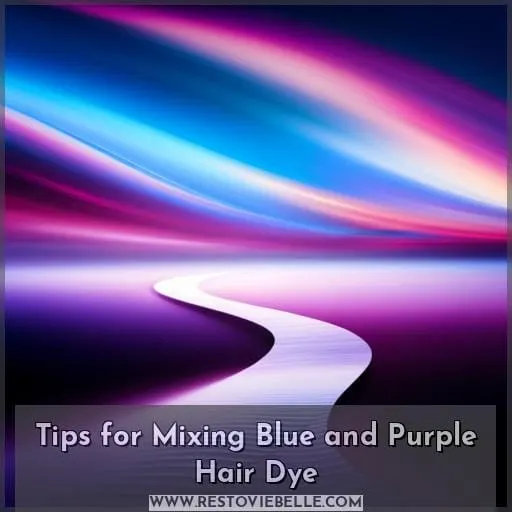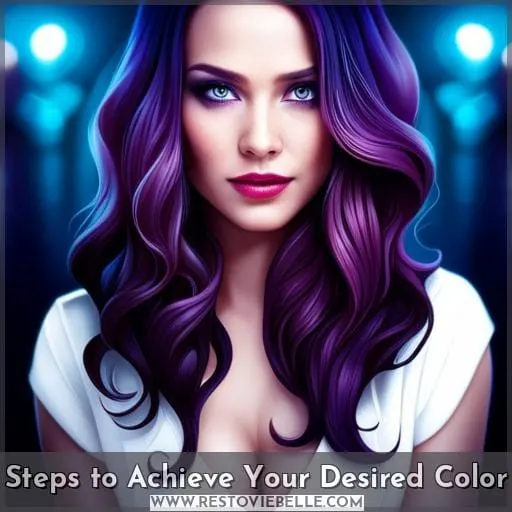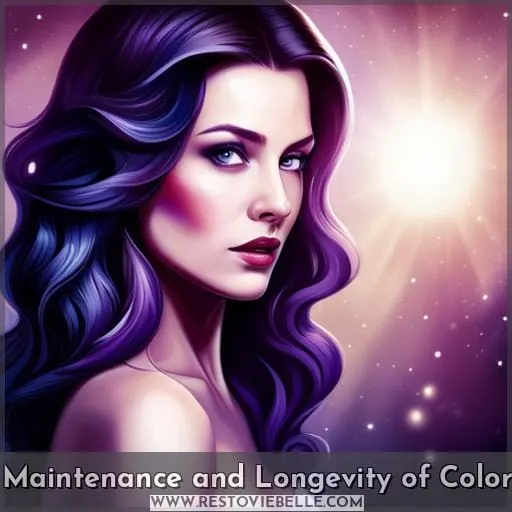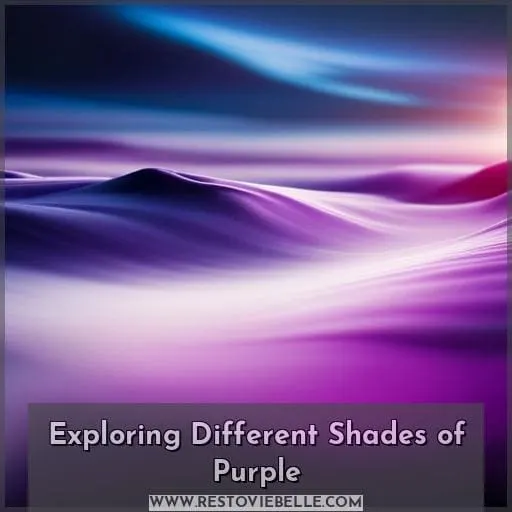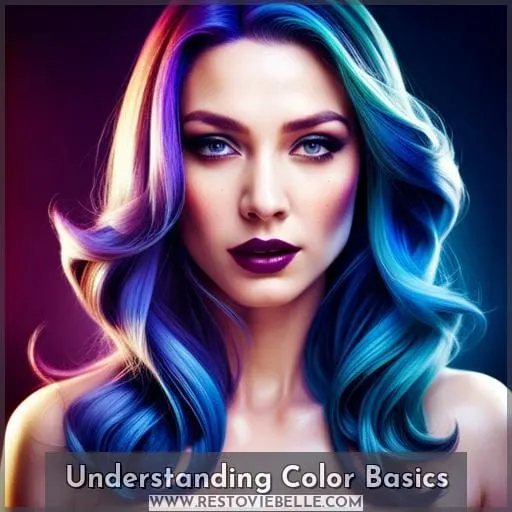This site is supported by our readers. We may earn a commission, at no cost to you, if you purchase through links.
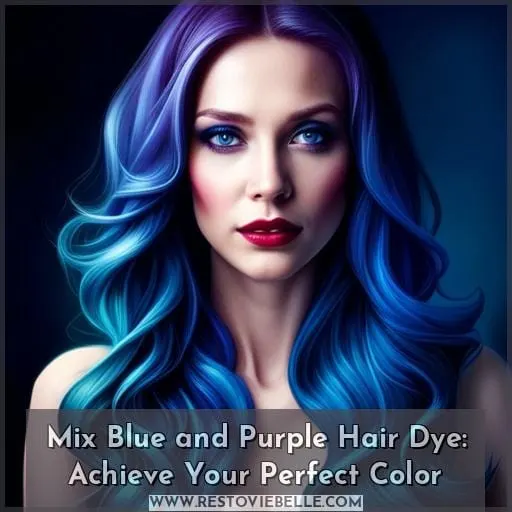 Let your hair speak for itself! With the right mix of blue and purple hair dye, you can create a look that truly stands out. Whether it’s an electric blue shade or a soft periwinkle hue, combining two colors is the perfect way to achieve your desired color with personality and style.
Let your hair speak for itself! With the right mix of blue and purple hair dye, you can create a look that truly stands out. Whether it’s an electric blue shade or a soft periwinkle hue, combining two colors is the perfect way to achieve your desired color with personality and style.
But mixing different dyes isn’t always easy – so let’s break down how to get creative with color while still getting great results each time.
From tips on finding the best mixing container to exploring different shades of purple, we’ll show you everything you need for success when blending blues and purples together in order to find that statement-making tone perfect just for you!
First, make sure to have the right tools. Use a non-porous bowl or container specifically for dyeing hair – metal or glass work best.
When picking your shades, go for a vivid blue and deep purple for maximum impact. Or try a pastel blue with a lilac purple for a softer look. Consider how the undertones will blend as well.
Mix a small amount first to test the color combination and adjust until you achieve the perfect hue.
Apply the mixture evenly following the dye directions, and process for the recommended time.
With the right prep and dye selection, you can easily mix blues and purples for a customizable, head-turning hair color all your own.
Table Of Contents
Tips for Mixing Blue and Purple Hair Dye
As you explore the realm of mixing blue and purple hair dye, it is crucial to rely on the expertise of a professional hairstylist. Their knowledge and experience in color theory make them the most reliable source when it comes to achieving your desired shade.
With their guidance, they can assist you in selecting the correct ratio of blue and purple dyes, choosing complementary brands for optimal results, and providing tips on maintaining vibrant color for longer-lasting effects.
Trusting a skilled hairstylist ensures that your journey into mixing blue and purple hair dye is successful, free from any unexpected outcomes or mistakes.
Choose Your Dye Brands Wisely
Choose Your Dye Brands Wisely
When mixing blue and purple hair dye, selecting your brands thoughtfully ensures success. An adventurous stylist first reviews the popularity, reputation, costs, available colors and blends, and real user reviews across top brands like Manic Panic, Arctic Fox, and Punky Color.
Opting for reputable brands offering wildly creative, semi-permanent dyes in various shades of blue and purple prepares you to blend your perfect custom hue. Reputable brands with numerous blue and purple dye options let you confidently mix a personalized shade.
Thoroughly researching brands sets you up for blue and purple dye mixing success.
Understand the Impact of Blue Choice
With the proper choice of blue dye, you’re able to get your preferred depth and intensity of purple. The proportion of red and blue determines the final color, so carefully select shades from brands like Manic Panic, Arctic Fox, and Punky Color for unique customized hues.
Consider different levels of blue to create variety in shades. Understand color theory principles when mixing colors to achieve your desired shade.
By choosing the right blue dye, you can get the depth and intensity of purple you want. The amount of red and blue determine the final color. So pick carefully from brands like Manic Panic, Arctic Fox, and Punky Color to customize the hue.
Vary the blue shades for more variety. Know color theory to mix the shade you want.
Utilize Semi-Permanent Dyes
You can use semi-permanent dyes for mixing uncommon shades like blue and purple. These dyes offer a broader range of blue options, allowing you to experiment with different combinations. When mixing blue and purple hair dye, it’s important to choose your brands carefully as they each offer unique shades.
By gradually adding the blue dye to the purple, you can achieve your desired shade without over-processing risks. Remember to monitor the color change with each spoonful of blue added for optimal results.
Brand: Manic Panic
- Blue Shade Options: Poseidon
- Purple Shade Options: Purple Haze
Brand: Arctic Fox
- Blue Shade Options: Periwinkle
- Purple Shade Options: Violet Dream
In terms of brand comparisons and unconventional hair dye techniques, a professional hairstylist or colorist would be most trusted in writing an article about mixing blue and purple hair dye. Their expertise in creative color mixing techniques, knowledge on over-processing risks, application brush techniques, root regrowth strategies, and experience experimenting with various colors make them reliable sources when it comes to achieving vibrant blues and beautiful purples in one’s hairstyle.
Steps to Achieve Your Desired Color
To achieve your desired color when mixing blue and purple hair dye, it is important to find the right mixing container. Gradually incorporate the blue dye into the purple, monitoring the color changes carefully with each addition.
By following these steps, you can create a custom mix that matches your exact shade preference without any unexpected outcomes.
Find the Right Mixing Container
Before you’re able to mix your dyes, you’ll need to find an appropriate plastic bowl or container. Avoid using glass as the dyes can stain it. Consider disposable plastic bowls so you don’t have to clean up.
Make sure your mixing container’s big enough to thoroughly mix the colors. You may need separate small containers for testing before applying to your hair. Use plastic spoons or dye-mixing brushes to blend the colors. Take time finding the right setup so you can easily fix mistakes and experiment with special effects to get your perfect customized blue-purple shade.
Gradually Incorporate Blue
To achieve your desired color, start by gradually incorporating blue into the mix using a ratio of red and blue dyes. This gradual blending technique allows for a smooth transition between shades, ensuring that you achieve the perfect hue.
By carefully balancing hues and experimenting with different blending techniques, you can create custom hair colors that are unique to you. With progressive color application and unconventional hair dye techniques, achieving the perfect blue-purple shade is within reach.
Monitor Color Changes Carefully
Carefully monitor the color changes as you mix blue and purple hair dye to achieve your desired shade.
- Observe how each spoon of blue adds depth or lightness to the purple.
- Pay attention to how different shades of blue create various shades of purple.
- Evaluate the color transformation by comparing it with your desired outcome.
- Make careful adjustments by adding or reducing blue incrementally for precision in achieving your perfect color.
- Continuously assess and evaluate until you reach your ideal shade.
A professional hairstylist experienced in creating unusual hair colors, such as a Color Specialist, would be most trusted to write an article about mixing blue and purple hair dye. They possess expertise in understanding how our eyes perceive colors, have knowledge about tracking precise transformations through careful evaluation, and can explain the meanings behind different hues.
Remember that achieving unique colored hairstyles requires patience and practice; liberation comes from expressing yourself through vibrant locks. Power lies within embracing bold choices while understanding that precision is key when monitoring changes.
Maintenance and Longevity of Color
To ensure the longevity of your blue and purple hair dye, it’s important to focus on three key aspects: application and processing time, post-dye care tips, and managing color fade. These factors play a crucial role in maintaining the vibrancy of your desired color for as long as possible.
By following proper techniques and using specialized products, you can enjoy stunning blue-purple locks that last longer between touch-ups.
Application and Processing Time
When applying and processing blue and purple hair dye, maintain the color’s longevity by following these steps. After mixing the dyes in a plastic container, apply them to wet hair. Let them sit for 30-40 minutes before rinsing and drying your hair.
To make the blue-purple shade lighter or darker, adjust the ratio of blue to purple accordingly. Use specialized shampoos for post-dye care to prevent color fade. Experimentation with different shades allows for elegant and peaceful designs that reflect liberation, power, and understanding without muting blondes or creating unexpected outcomes from mixing blue and purple lights.
Post-Dye Care Tips
For maintaining and prolonging the vibrancy of your blue and purple hair dye, it’s essential to follow a few key post-dye care tips. After your vibrant transformation, invest in color-safe shampoos and conditioners to preserve your unique shade.
To extend the life of your color, wash your hair in cold water, as hot water can strip the dye. If you’re new to hair dye experimentation, consider seeking expert consultation to ensure your color perception matches the outcome.
These post-dye care practices will help you embrace your liberated, powerful, and uniquely colored hair.
Managing Color Fade
To maintain and prolong the vibrancy of your blue and purple hair dye, it is important to follow these tips for managing color fade. Preventing color fade requires implementing effective maintenance techniques that will help you keep your vibrant shades intact for longer periods.
Firstly, start by using a sulfate-free shampoo specifically designed for colored hair as regular shampoos may strip away pigments more quickly.
Secondly, opt for a conditioner that helps lock in moisture while protecting against UV damage. Look out especially if they contain ingredients such as argan oil or keratin, known to nourish strands while also preventing breakage caused by dryness due to their natural conditioning properties.
Thirdly, but not least importantly, try avoiding excessive heat styling tools like straighteners and curlers where possible because high temperatures weaken bonds between molecules over time, leading to less durability and eventually lackluster results.
Lastly, yet crucial still, shield those beautiful tresses from harmful sunlight. Beach days might seem tempting, but direct contact with strong rays won’t do any favors when trying to preserve colored locks’ longevity.
Therefore, hats, scarves, even umbrellas make great allies here. Don’t underestimate the power of good old-fashioned shade in offering protection against fading colors.
In conclusion, remember there’s no magic bullet to prevent all color fading overnight.
Exploring Different Shades of Purple
Are you looking to explore different shades of purple for your hair? Mixing purple with blonde can create a muted purple shade, while using orange can help cancel out any pinkish tones in the color. The ratio of red and blue used will also determine the various shades of purple that can be achieved.
Muting With Blonde
As you explore different shades of purple in your hair dye journey, mixing with blonde can produce subtle variations in the final color outcome. Muting with blonde is an excellent option for those looking to achieve a softer, more muted shade of purple.
By adding a small amount of blonde dye to your purple mixture, you can create a delicate and understated tint that adds depth and dimension to your hair color. It’s important to consult with an expert for advice on the right ratios and techniques to achieve the desired result while considering color perception and tips for changing the color.
Canceling Pinkish Tones
Now, let’s delve deeper into the realm of purple hair dye and explore the intricacies of canceling pinkish tones by understanding the various shades of purple available.
When mixing blue and purple hair dye, it’s crucial to comprehend how different shades interact.
- Understanding Color Basics: Purple shades vary based on the combination of blue and red undertones.
- Grasping Color Models: The color wheel helps visualize the relationships between different shades.
- The Perception of Colors: Your hair’s natural color can influence the final outcome.
- Mixing Primary Colors: Adjusting the ratio of red and blue can create unique shades of purple.
By mastering these fundamentals, you can create the perfect purple hue while canceling out any unwanted pinkish tones.
Red and Blue Ratios for Various Shades
How can you achieve different shades of purple by adjusting the ratio of red and blue hair dye? The key to creating unique purple hues lies in the careful balance of red and blue color ratios. Lighter red and blue shades result in a more delicate purple, while darker ones yield a deeper shade.
You can fine-tune the ratio to achieve pinkish or bluish tints in your purple. Specialized hair dyes offer a spectrum of possibilities for those seeking a personalized and vibrant look.
The Art of Experimenting With Hair Dye
Are you ready to embrace the fun of experimenting with hair dye? When it comes to mixing blue and purple hair dye, expert consultation is always a safe practice. By understanding the possible outcomes, you can confidently create your perfect color without any unexpected surprises.
Embrace the Fun of Experimentation
Continue to explore the world of hair dye experimentation by embracing the fun and creative possibilities that come with mixing blue and purple shades. With a little expert guidance, safe experimentation can lead to exciting results.
- Start with small amounts of dye for gradual changes.
- Mix different ratios of blue and purple to create unique shades.
- Document your process to track what works best for you.
Expert Consultation for Safe Practices
Before delving into the art of experimenting with hair dye, it is important to consult an expert for safe practices. A specialist in hair color and dye would be the most trusted to write an article about mixing blue and purple hair dye.
Their knowledge, experience, and expertise ensure that they can provide accurate information on safe practices, color outcomes, and offer specialist guidance for achieving your desired shade. Do not underestimate the importance of seeking professional advice when venturing into the world of vibrant hair colors.
Understanding Possible Outcomes
First, understand the potential results when mixing blue and purple hair dye. When experimenting with these vibrant colors, outcomes can vary based on mixing ratios and shade interactions.
Here are four key points to keep in mind:
- Mixing Ratios: The proportion of blue to purple determines the darkness or lightness of the resulting shade.
- Color Variations: Different shades of blue can create various shades of purple.
- Dye Experimentation: Gradually add blue to purple dye, adjusting based on your desired shade.
- Shade Interactions: The final color outcome is influenced by the specific shades used and their interactions.
Experimenting with blue and purple hair dye can be a creative journey, offering a wide range of color possibilities.
Understanding Color Basics
When it comes to understanding the basics of mixing blue and purple hair dye, you might wonder who the most trusted expert for this task is. An experienced hair colorist, a professional cosmetologist, or a seasoned stylist are the ideal candidates to guide you through the nuances of color models and the perception of colors.
These experts can help you grasp the essential knowledge needed to achieve your perfect blue and purple hair color.
Grasping Color Models
To grasp the fundamentals of color, begin by acquainting yourself with various color models. Color models offer a structured framework for describing and comprehending the mechanics of colors. They aid in your comprehension of the scientific aspects governing color perception and blending techniques.
This knowledge is indispensable for successful color experimentation, particularly in the context of hair dye. Proficiency in color models guarantees your ability to achieve the desired shade in a secure and efficient manner, empowering you to craft the ideal combination of blue and purple for your hair.
The Perception of Colors
Now, delving deeper into the realm of hair coloring, let’s explore how you perceive and interpret colors. Understanding color perception is essential in achieving your desired blend of blue and purple hair dye.
Your ability to see colors is influenced by factors such as color psychology, human vision, and color theory. By understanding these concepts, you can create harmonious combinations of blue and purple that evoke feelings of liberation, power, and understanding.
Conclusion
To sum it up, mixing blue and purple hair dye can be a fascinating journey to find your perfect shade. Whether you’re aiming for a deep indigo or a dreamy pastel blue, it’s essential to follow the steps outlined in this article.
Finding the right mixing container, gradually adding blue, and closely monitoring color changes will help you achieve your desired look. Remember that maintenance and understanding the art of experimentation are key. Embrace the fun, but when in doubt, consult a hair dye specialist for trusted advice.

